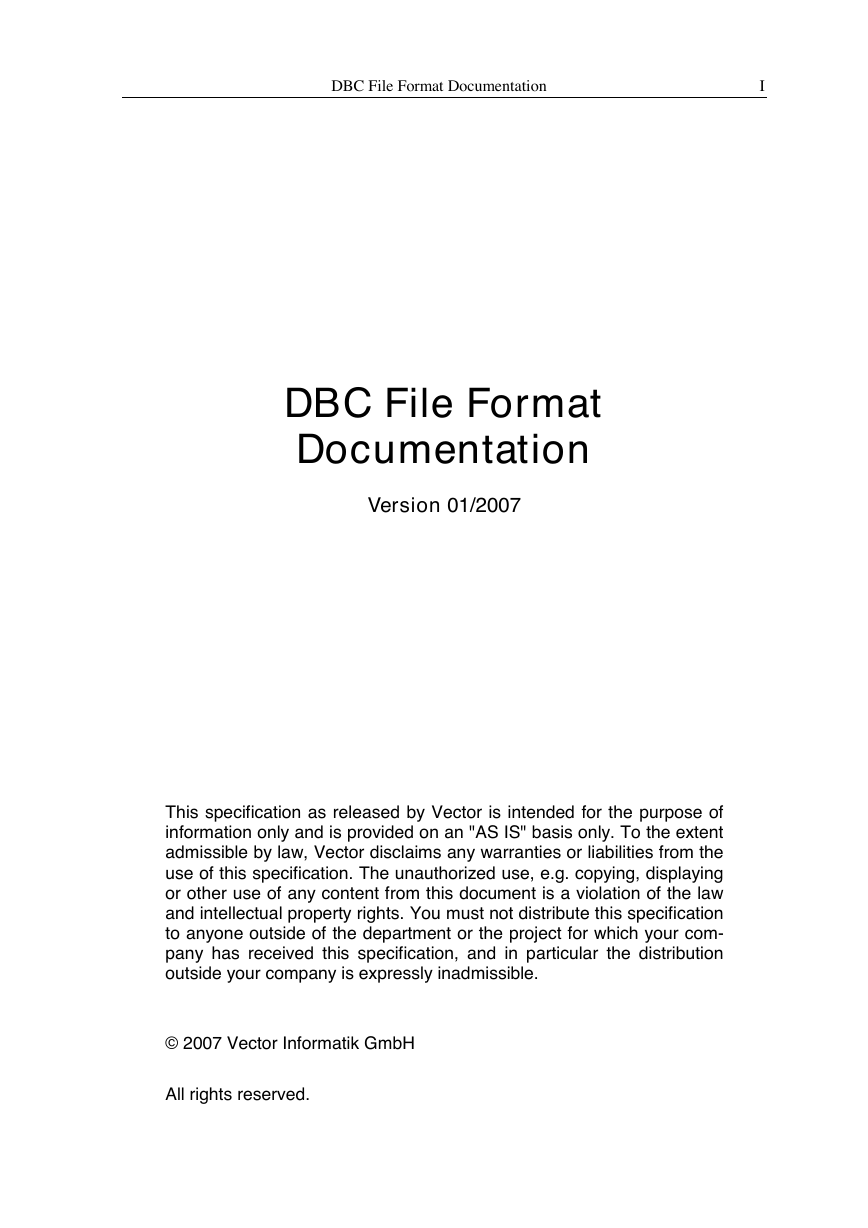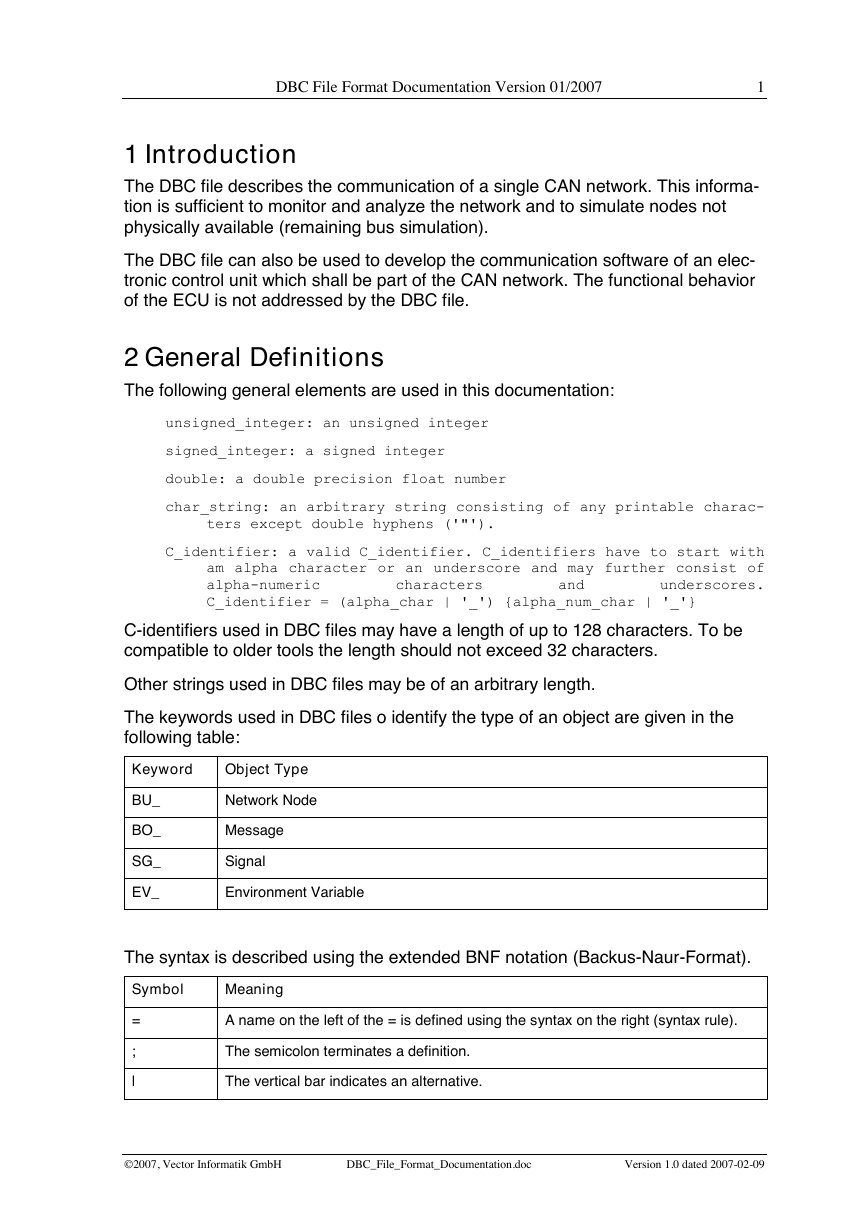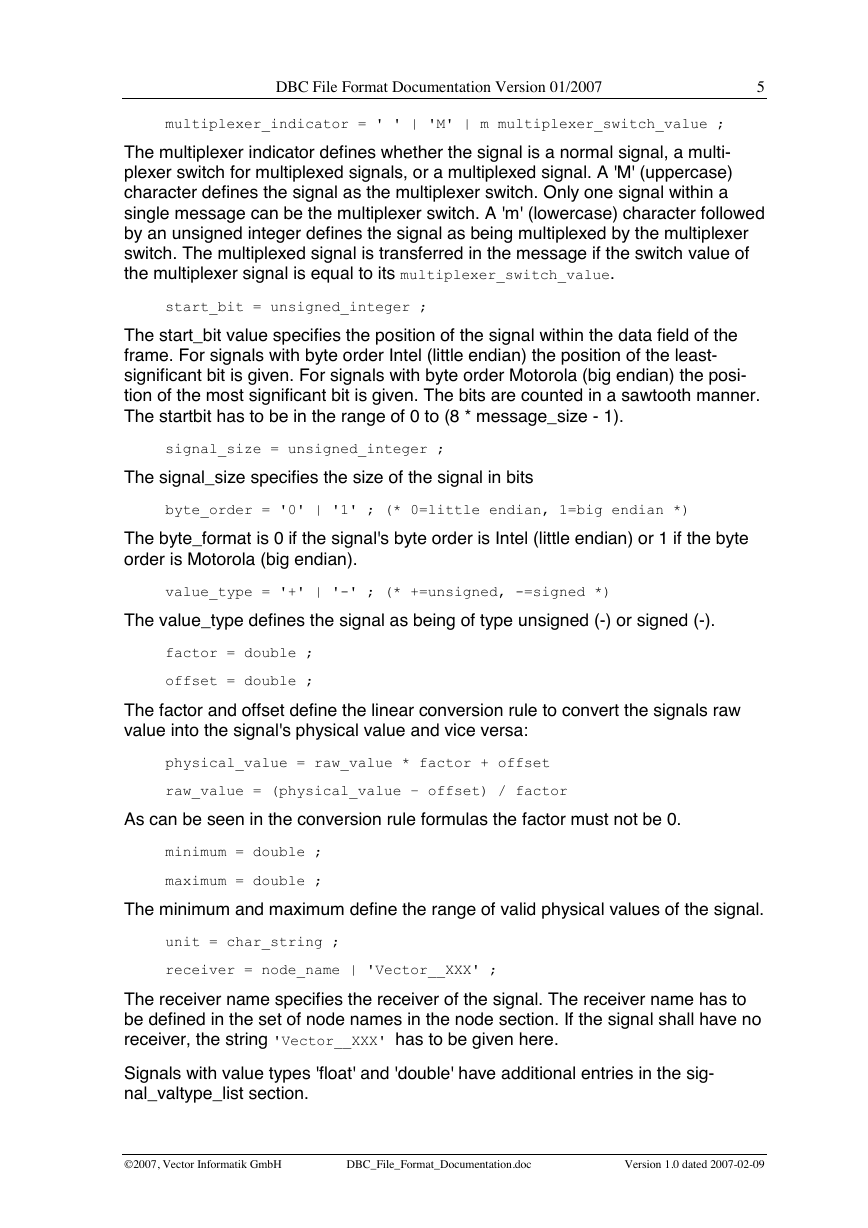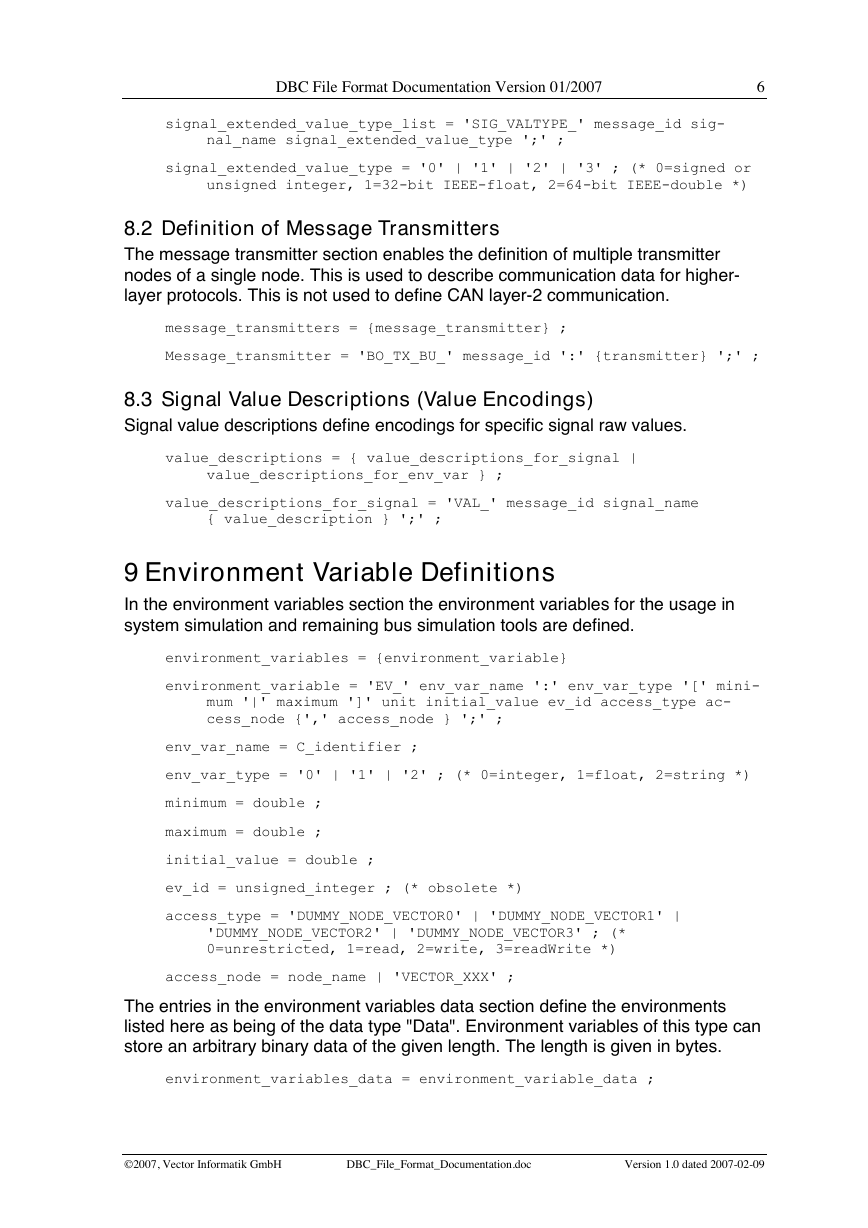DBC File Format Documentation
I
DBC File Format
Documentation
Version 01/2007
This specification as released by Vector is intended for the purpose of
information only and is provided on an "AS IS" basis only. To the extent
admissible by law, Vector disclaims any warranties or liabilities from the
use of this specification. The unauthorized use, e.g. copying, displaying
or other use of any content from this document is a violation of the law
and intellectual property rights. You must not distribute this specification
to anyone outside of the department or the project for which your com-
pany has received this specification, and in particular the distribution
outside your company is expressly inadmissible.
© 2007 Vector Informatik GmbH
All rights reserved.
�
DBC File Format Documentation
II
Document Management
Revision History
Version
1.0 of 2007-02-09 Qu
Editor Description
Specification created
Table of contents
1 Introduction ..................................................................................................................1
2 General Definitions ......................................................................................................1
3 Structure of the DBC File.............................................................................................2
4 Version and New Symbol Specification......................................................................3
5 Bit Timing Definition ....................................................................................................3
6 Node Definitions...........................................................................................................3
7 Value Table Definitions................................................................................................3
7.1 Value Descriptions (Value Encodings) .................................................................................4
8 Message Definitions.....................................................................................................4
8.1 Signal Definitions..................................................................................................................4
8.2 Definition of Message Transmitters ......................................................................................6
8.3 Signal Value Descriptions (Value Encodings) ......................................................................6
9 Environment Variable Definitions ...............................................................................6
10
11
12
9.1 Environment Variable Value Descriptions............................................................................7
Signal Type and Signal Group Definitions .........................................................7
Comment Definitions ...........................................................................................7
User Defined Attribute Definitions ......................................................................8
12.1 Attribute Definitions..............................................................................................................8
12.2 Attribute Values ....................................................................................................................8
13
Examples ..............................................................................................................8
�
DBC File Format Documentation Version 01/2007
1
1 Introduction
The DBC file describes the communication of a single CAN network. This informa-
tion is sufficient to monitor and analyze the network and to simulate nodes not
physically available (remaining bus simulation).
The DBC file can also be used to develop the communication software of an elec-
tronic control unit which shall be part of the CAN network. The functional behavior
of the ECU is not addressed by the DBC file.
2 General Definitions
The following general elements are used in this documentation:
unsigned_integer: an unsigned integer
signed_integer: a signed integer
double: a double precision float number
char_string: an arbitrary string consisting of any printable charac-
ters except double hyphens ('"').
C_identifier: a valid C_identifier. C_identifiers have to start with
am alpha character or an underscore and may further consist of
alpha-numeric
underscores.
C_identifier = (alpha_char | '_') {alpha_num_char | '_'}
characters
and
C-identifiers used in DBC files may have a length of up to 128 characters. To be
compatible to older tools the length should not exceed 32 characters.
Other strings used in DBC files may be of an arbitrary length.
The keywords used in DBC files o identify the type of an object are given in the
following table:
Keyword
Object Type
Network Node
Message
Signal
Environment Variable
BU_
BO_
SG_
EV_
The syntax is described using the extended BNF notation (Backus-Naur-Format).
Symbol
Meaning
=
;
|
A name on the left of the = is defined using the syntax on the right (syntax rule).
The semicolon terminates a definition.
The vertical bar indicates an alternative.
2007, Vector Informatik GmbH
DBC_File_Format_Documentation.doc
Version 1.0 dated 2007-02-09
�
DBC File Format Documentation Version 01/2007
2
[ … ]
{ … }
( … )
' … '
The definitions within brackets are optional (zero or one occurrence).
The definitions within braces repeated (zero or multiple occurrences)
Parentheses define grouped elements.
Text in hyphens has to appear as defined.
(* … *)
Comment.
3 Structure of the DBC File
The DBC file format has the following overall structure:
DBC_file =
(*obsolete but required*)
version
new_symbols
bit_timing
nodes
value_tables
messages
message_transmitters
environment_variables
environment_variables_data
signal_types
comments
attribute_definitions
sigtype_attr_list
attribute_defaults
attribute_values
value_descriptions
category_definitions
categories
filter
signal_type_refs
signal_groups
signal_extended_value_type_list ;
(*obsolete*)
(*obsolete*)
(*obsolete*)
DBC files describing the basic communication of a CAN network include the fol-
lowing sections:
• Bit_timing
This section is required but is normally empty.
• nodes
This section is required and defines the network nodes.
• messages
This section defines the messages and the signals.
The following sections aren't used in normal DBC files. They are defined here for
the sake of completeness only:
• signal_types
• sigtype_attr_list
• category_definitions
• categories
2007, Vector Informatik GmbH
DBC_File_Format_Documentation.doc
Version 1.0 dated 2007-02-09
�
DBC File Format Documentation Version 01/2007
3
• filter
• signal_type_refs
• signal_extended_value_type_list
DBC files that describe the CAN communication and don't define any additional
data for system or remaining bus simulations don't include environment variables.
4 Version and New Symbol Specification
The DBC files contain a header with the version and the new symbol entries. The
version either is empty or is a string used by CANdb editor.
version = ['VERSION' '"' { CANdb_version_string } '"' ];
new_symbols = [ '_NS' ':' ['CM_'] ['BA_DEF_'] ['BA_'] ['VAL_']
['CAT_DEF_'] ['CAT_'] ['FILTER'] ['BA_DEF_DEF_'] ['EV_DATA_']
['ENVVAR_DATA_'] ['SGTYPE_'] ['SGTYPE_VAL_'] ['BA_DEF_SGTYPE_']
['BA_SGTYPE_'] ['SIG_TYPE_REF_'] ['VAL_TABLE_'] ['SIG_GROUP_']
['SIG_VALTYPE_'] ['SIGTYPE_VALTYPE_'] ['BO_TX_BU_']
['BA_DEF_REL_'] ['BA_REL_'] ['BA_DEF_DEF_REL_'] ['BU_SG_REL_']
['BU_EV_REL_'] ['BU_BO_REL_'] ];
5 Bit Timing Definition
The bit timing section defines the baudrate and the settings of the BTR registers of
the network This section is obsolete and not used any more. Nevertheless he
keyword 'BS_' must appear in the DBC file.
bit_timing = 'BS_:' [baudrate ':' BTR1 ',' BTR2 ] ;
baudrate = unsigned_integer ;
BTR1 = unsigned_integer ;
BTR2 = unsigned_integer ;
6 Node Definitions
The node section defines the names of all participating nodes The names defined
in this section have to be unique within this section.
nodes = 'BU_:' {node_name} ;
node_name = C_identifier ;
7 Value Table Definitions
The value table section defines the global value tables. The value descriptions in
value tables define value encodings for signal raw values. In commonly used DBC
files the global value tables aren't used, but the value descriptions are defined for
each signal independently.
value_tables = {value_table} ;
2007, Vector Informatik GmbH
DBC_File_Format_Documentation.doc
Version 1.0 dated 2007-02-09
�
DBC File Format Documentation Version 01/2007
4
value_table = 'VAL_TABLE_' value_table_name {value_description}
';' ;
value_table_name = C_identifier ;
7.1 Value Descriptions (Value Encodings)
A value description defines a textual description for a single value. This value may
either be a signal raw value transferred on the bus or the value of an environment
variable in a remaining bus simulation.
value_description = double char_string ;
8 Message Definitions
The message section defines the names of all frames in the cluster as well as their
properties and the signals transferred on the frames.
messages = {message} ;
message = BO_ message_id message_name ':' message_size trans-
mitter {signal} ;
message_id = unsigned_integer ;
The message's CAN-ID. The CAN-ID has to be unique within the DBC file. If the
most significant bit of the CAN-ID is set, the ID is an extended CAN ID. The ex-
tended CAN ID can be determined by masking out the most significant bit with the
mask 0xCFFFFFFF.
message_name = C_identifier ;
The names defined in this section have to be unique within the set of messages.
message_size = unsigned_integer ;
The message_size specifies the size of the message in bytes.
transmitter = node_name | 'Vector__XXX' ;
The transmitter name specifies the name of the node transmitting the message.
The sender name has to be defined in the set of node names in the node section.
If the massage shall have no sender, the string 'Vector__XXX' has to be given
here.
8.1 Signal Definitions
The message's signal section lists all signals placed on the message, their position
in the message's data field and their properties.
signal = 'SG_' signal_name multiplexer_indicator ':' start_bit '|'
signal_size '@' byte_order value_type '(' factor ',' offset ')'
'[' minimum '|' maximum ']' unit receiver {',' receiver} ;
signal_name = C_identifier ;
The names defined here have to be unique for the signals of a single message.
2007, Vector Informatik GmbH
DBC_File_Format_Documentation.doc
Version 1.0 dated 2007-02-09
�
DBC File Format Documentation Version 01/2007
5
multiplexer_indicator = ' ' | 'M' | m multiplexer_switch_value ;
The multiplexer indicator defines whether the signal is a normal signal, a multi-
plexer switch for multiplexed signals, or a multiplexed signal. A 'M' (uppercase)
character defines the signal as the multiplexer switch. Only one signal within a
single message can be the multiplexer switch. A 'm' (lowercase) character followed
by an unsigned integer defines the signal as being multiplexed by the multiplexer
switch. The multiplexed signal is transferred in the message if the switch value of
the multiplexer signal is equal to its multiplexer_switch_value.
start_bit = unsigned_integer ;
The start_bit value specifies the position of the signal within the data field of the
frame. For signals with byte order Intel (little endian) the position of the least-
significant bit is given. For signals with byte order Motorola (big endian) the posi-
tion of the most significant bit is given. The bits are counted in a sawtooth manner.
The startbit has to be in the range of 0 to (8 * message_size - 1).
signal_size = unsigned_integer ;
The signal_size specifies the size of the signal in bits
byte_order = '0' | '1' ; (* 0=little endian, 1=big endian *)
The byte_format is 0 if the signal's byte order is Intel (little endian) or 1 if the byte
order is Motorola (big endian).
value_type = '+' | '-' ; (* +=unsigned, -=signed *)
The value_type defines the signal as being of type unsigned (-) or signed (-).
factor = double ;
offset = double ;
The factor and offset define the linear conversion rule to convert the signals raw
value into the signal's physical value and vice versa:
physical_value = raw_value * factor + offset
raw_value = (physical_value – offset) / factor
As can be seen in the conversion rule formulas the factor must not be 0.
minimum = double ;
maximum = double ;
The minimum and maximum define the range of valid physical values of the signal.
unit = char_string ;
receiver = node_name | 'Vector__XXX' ;
The receiver name specifies the receiver of the signal. The receiver name has to
be defined in the set of node names in the node section. If the signal shall have no
receiver, the string 'Vector__XXX' has to be given here.
Signals with value types 'float' and 'double' have additional entries in the sig-
nal_valtype_list section.
2007, Vector Informatik GmbH
DBC_File_Format_Documentation.doc
Version 1.0 dated 2007-02-09
�
DBC File Format Documentation Version 01/2007
6
signal_extended_value_type_list = 'SIG_VALTYPE_' message_id sig-
nal_name signal_extended_value_type ';' ;
signal_extended_value_type = '0' | '1' | '2' | '3' ; (* 0=signed or
unsigned integer, 1=32-bit IEEE-float, 2=64-bit IEEE-double *)
8.2 Definition of Message Transmitters
The message transmitter section enables the definition of multiple transmitter
nodes of a single node. This is used to describe communication data for higher-
layer protocols. This is not used to define CAN layer-2 communication.
message_transmitters = {message_transmitter} ;
Message_transmitter = 'BO_TX_BU_' message_id ':' {transmitter} ';' ;
8.3 Signal Value Descriptions (Value Encodings)
Signal value descriptions define encodings for specific signal raw values.
value_descriptions = { value_descriptions_for_signal |
value_descriptions_for_env_var } ;
value_descriptions_for_signal = 'VAL_' message_id signal_name
{ value_description } ';' ;
9 Environment Variable Definitions
In the environment variables section the environment variables for the usage in
system simulation and remaining bus simulation tools are defined.
environment_variables = {environment_variable}
environment_variable = 'EV_' env_var_name ':' env_var_type '[' mini-
mum '|' maximum ']' unit initial_value ev_id access_type ac-
cess_node {',' access_node } ';' ;
env_var_name = C_identifier ;
env_var_type = '0' | '1' | '2' ; (* 0=integer, 1=float, 2=string *)
minimum = double ;
maximum = double ;
initial_value = double ;
ev_id = unsigned_integer ; (* obsolete *)
access_type = 'DUMMY_NODE_VECTOR0' | 'DUMMY_NODE_VECTOR1' |
'DUMMY_NODE_VECTOR2' | 'DUMMY_NODE_VECTOR3' ; (*
0=unrestricted, 1=read, 2=write, 3=readWrite *)
access_node = node_name | 'VECTOR_XXX' ;
The entries in the environment variables data section define the environments
listed here as being of the data type "Data". Environment variables of this type can
store an arbitrary binary data of the given length. The length is given in bytes.
environment_variables_data = environment_variable_data ;
2007, Vector Informatik GmbH
DBC_File_Format_Documentation.doc
Version 1.0 dated 2007-02-09
�
















 2023年江西萍乡中考道德与法治真题及答案.doc
2023年江西萍乡中考道德与法治真题及答案.doc 2012年重庆南川中考生物真题及答案.doc
2012年重庆南川中考生物真题及答案.doc 2013年江西师范大学地理学综合及文艺理论基础考研真题.doc
2013年江西师范大学地理学综合及文艺理论基础考研真题.doc 2020年四川甘孜小升初语文真题及答案I卷.doc
2020年四川甘孜小升初语文真题及答案I卷.doc 2020年注册岩土工程师专业基础考试真题及答案.doc
2020年注册岩土工程师专业基础考试真题及答案.doc 2023-2024学年福建省厦门市九年级上学期数学月考试题及答案.doc
2023-2024学年福建省厦门市九年级上学期数学月考试题及答案.doc 2021-2022学年辽宁省沈阳市大东区九年级上学期语文期末试题及答案.doc
2021-2022学年辽宁省沈阳市大东区九年级上学期语文期末试题及答案.doc 2022-2023学年北京东城区初三第一学期物理期末试卷及答案.doc
2022-2023学年北京东城区初三第一学期物理期末试卷及答案.doc 2018上半年江西教师资格初中地理学科知识与教学能力真题及答案.doc
2018上半年江西教师资格初中地理学科知识与教学能力真题及答案.doc 2012年河北国家公务员申论考试真题及答案-省级.doc
2012年河北国家公务员申论考试真题及答案-省级.doc 2020-2021学年江苏省扬州市江都区邵樊片九年级上学期数学第一次质量检测试题及答案.doc
2020-2021学年江苏省扬州市江都区邵樊片九年级上学期数学第一次质量检测试题及答案.doc 2022下半年黑龙江教师资格证中学综合素质真题及答案.doc
2022下半年黑龙江教师资格证中学综合素质真题及答案.doc